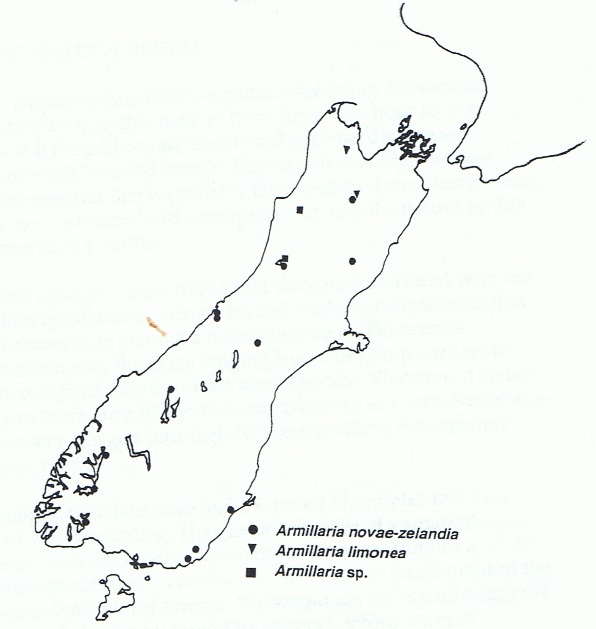PESTS AND DISEASES OF FORESTRY IN NEW ZEALAND
Armillaria species distribution in the South Island
Scion is the leading provider of forest-related knowledge in New Zealand
Formerly known as the Forest Research Institute, Scion has been a leader in research relating to forest health for over 50 years. The Rotorua-based Crown Research Institute continues to provide science that will protect all forests from damage caused by insect pests, pathogens and weeds. The information presented below arises from these research activities.
From Forest Health News No. 42, May 1995.
In 1988 lan Hood published a map of Armillaria distribution based on records held at NZ FRI. This data consisted primarily of records of Armillaria on Pinus radiata and a few on other exotic species. Many of these records simply note the presence of rhizomorphs and mycelial sheets and do not record which Armillaria species were involved. And many of the records before 1980 are for A. mellea which we now know does not occur in New Zealand. So we have a good idea of the distribution of the genus but not of the species. As part of the Armillaria taxonomy project I am mapping their distribution based on fruitbody collections. At present there are only seventeen of these records for the South Island but they indicate that A. novae-zelandiae is distributed over the entire island, A. limonea is restricted to Nelson/ Marlborough, and the third unnamed species in northern Westland.
Note: all collections of Armillaria fruitbodies would be greatly appreciated.
(Geoff Ridley )

From Forest Health News No. 31, May 1994.
I recently spent twelve days in the South Island with Dr Ron Petersen, University of Tennessee, collecting agarics (mushrooms) and in particular I was looking for Armillaria in Nothofagus forest. Forests searched ranged from Fiordland National Park to Nelson Lakes National Park. It was interesting to note that south of the west coast beech gap only Armillaria novae-zelandiae was encountered. At Lake Hochstetter, just north of Greymouth, the elusive third species Armillaria 'hinulea' dominated. And around Lakes Rotoiti and Rotoroa there were massive fruitings of A.limonea and only the occasional A.novae-zelandiae. Two collections of the third spedes, one from the west coast / Nelson area and the other from Tongariro, were initially assigned to the Australian species A.hinulea by Kile & Waning (1983). However in 1988 Kile & Watling attempted to mate Australian and New Zealand isolates and found them to be intersterile indicating the New Zealand species to be a new distinct biological species. This new species needs to be confirmed hence my trip and the call for Armillaria collections in FHNews 30. The new species can be distinguished from A.novae-zelandiae by its non-slimy cap and predominantly pinkish-brown coloration particularly noticeable in the gills (see lan Hood's 'Fungi on Wood' p.310).
(Geoff Ridley)
This information is intended for general interest only. It is not intended to be a substitute for specific specialist advice on any matter and should not be relied on for that purpose. Scion will not be liable for any direct, indirect, incidental, special, consequential or exemplary damages, loss of profits, or any other intangible losses that result from using the information provided on this site.
(Scion is the trading name of the New Zealand Forest Research Institute Limited.)

 Farm Forestry New Zealand
Farm Forestry New Zealand

